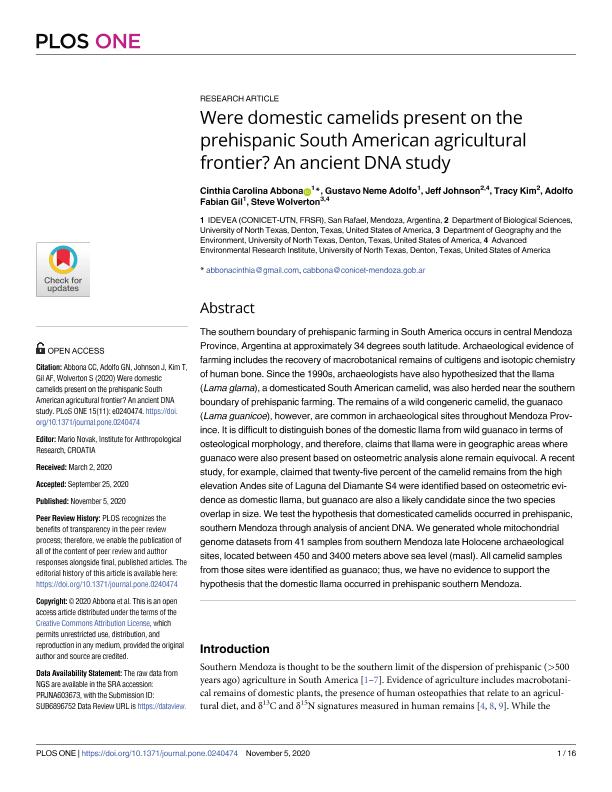Artículo
Were domestic camelids present on the prehispanic South American agricultural frontier? An ancient DNA study
Abbona, Cinthia Carolina ; Neme, Gustavo Adolfo
; Neme, Gustavo Adolfo ; Johnson, Jeff; Kim, Tracy; Gil, Adolfo Fabian
; Johnson, Jeff; Kim, Tracy; Gil, Adolfo Fabian ; Wolverton, Steve
; Wolverton, Steve
 ; Neme, Gustavo Adolfo
; Neme, Gustavo Adolfo ; Johnson, Jeff; Kim, Tracy; Gil, Adolfo Fabian
; Johnson, Jeff; Kim, Tracy; Gil, Adolfo Fabian ; Wolverton, Steve
; Wolverton, Steve
Fecha de publicación:
05/11/2020
Editorial:
Public Library of Science
Revista:
Plos One
ISSN:
1932-6203
Idioma:
Inglés
Tipo de recurso:
Artículo publicado
Clasificación temática:
Resumen
The southern boundary of prehispanic farming in South America occurs in central Mendoza Province, Argentina at approximately 34 degrees south latitude. Archaeological evidence of farming includes the recovery of macrobotanical remains of cultigens and isotopic chemistry of human bone. Since the 1990s, archaeologists have also hypothesized that the llama (Lama glama), a domesticated South American camelid, was also herded near the southern boundary of prehispanic farming. The remains of a wild congeneric camelid, the guanaco (Lama guanicoe), however, are common in archaeological sites throughout Mendoza Province. It is difficult to distinguish bones of the domestic llama from wild guanaco in terms of osteological morphology, and therefore, claims that llama were in geographic areas where guanaco were also present based on osteometric analysis alone remain equivocal. A recent study, for example, claimed that twenty-five percent of the camelid remains from the high elevation Andes site of Laguna del Diamante S4 were identified based on osteometric evidence as domestic llama, but guanaco are also a likely candidate since the two species overlap in size. We test the hypothesis that domesticated camelids occurred in prehispanic, southern Mendoza through analysis of ancient DNA. We generated whole mitochondrial genome datasets from 41 samples from southern Mendoza late Holocene archaeological sites, located between 450 and 3400 meters above sea level (masl). All camelid samples from those sites were identified as guanaco; thus, we have no evidence to support the hypothesis that the domestic llama occurred in prehispanic southern Mendoza.
Archivos asociados
Licencia
Identificadores
Colecciones
Articulos (IDEVEA)
Articulos de INSTITUTO DE EVOLUCION, ECOLOGIA HISTORICA Y AMBIENTE
Articulos de INSTITUTO DE EVOLUCION, ECOLOGIA HISTORICA Y AMBIENTE
Citación
Abbona, Cinthia Carolina; Neme, Gustavo Adolfo; Johnson, Jeff; Kim, Tracy; Gil, Adolfo Fabian; et al.; Were domestic camelids present on the prehispanic South American agricultural frontier? An ancient DNA study; Public Library of Science; Plos One; 15; 11; 5-11-2020; 1-16
Compartir
Altmétricas



